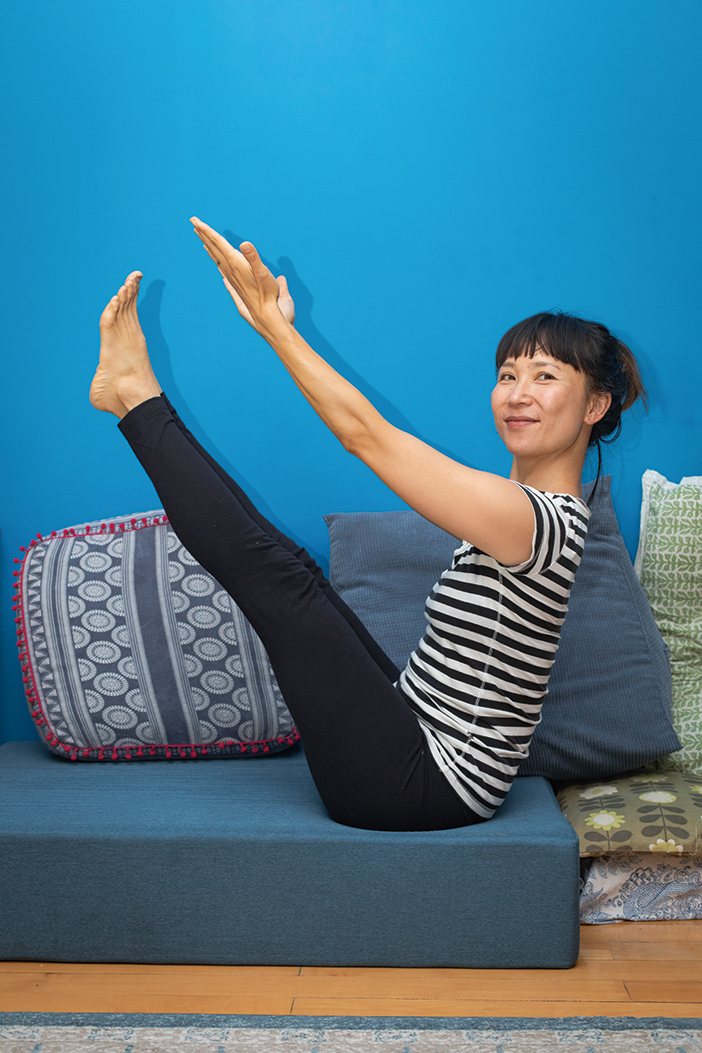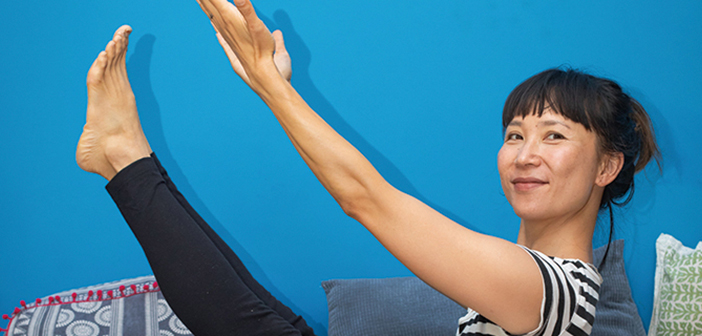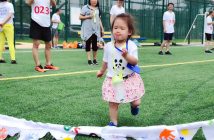Trigger warning: this article contains references to abuse and childhood trauma.
Yoga is a well-established part of many people’s daily lives, helping them stay fit and promoting mental wellbeing. And unlike many alternative practices, there is a solid body of scientific evidence for the benefits it brings. But can it help people who have experienced severe trauma, including abuse or rape? One Beijing-based practitioner believes it can, and is running special classes for women who have survived such experiences.
Yonnie Fung, who was born in Hong Kong and grew up in Australia, came to Beijing as an intellectual property lawyer.
“One day,” she tells us, “shivering in my freezing air-conditioned office, I decided the world could do with one less corporate lawyer and one more yoga teacher.”
Her involvement with yoga goes back to her childhood.
“I started 30 years ago, as a kid with a hippy gymnastics teacher. I became a lot more serious about yoga practice as a way to stay afloat in a high-stress work environment. I did long hours, constantly traveled, ate takeaway meals in the office daily, and sat on my chair far more than our species was designed to do. I practiced yoga daily to clear my mind, to keep perspective, to stay calm in the midst of stress.”
Her career as a teacher was also a learning journey.
“I started as an Ashtanga yoga teacher,” she says. “Over the years of teaching, I noticed that Ashtanga couldn’t adequately cater to all the people that came through my door. Some people came with back injuries. Some with neck injuries. Some couldn’t bear weight on their wrists. The guru of Ashtanga, Pattabhi Jois, is often quoted as saying that Ashtanga was for everyone: the old, the sick, everyone except the lazy. But the reality of what I was seeing was that the guru wasn’t right. So I went in search for yoga techniques that would be more accessible and therapeutic. I gravitated towards the more scientifically rigorous methods of a physiotherapist and Hatha yoga teacher called Simon Borg Olivier. From him, I learned to teach yoga from a framework more informed by evidence and reason.
“For three years I took a Grad Diploma in Yoga Therapy with Dr. Natesan Chandrasekaran. He’s a medical doctor and a yoga therapist who set up one of the first yoga therapy clinics in the world. From morning to evening, I’d sit in his clinic and observe, then eventually assist as he used yoga postures, breathing, visualizations and other tools to help his patients. In the whole time I was with him, I only saw him prescribe medication three times. It was also interesting to me that his clients were often surgeons and doctors who would bring in their own family members. Dr. Chandrasekaran is still my supervisor, and I consult with him on difficult cases for a sanity check.”
We ask Fung how her trauma therapy work came about.
“Trauma-sensitive yoga classes were coined by David Emerson, a social worker and yoga teacher. He, in consultation with neuroscientist and former Harvard professor Bessel Van der Kolk, designed the Trauma-Sensitive Yoga (TSY) program as an adjunct treatment for people who had experienced complex trauma. My classes are mainly for people who have experienced trauma in the context of relationships, where they know the perpetrator and the trauma is not a one-off event but happens over time. This might be victims of incest, or rape, or abuse and neglect.”
This sort of abuse can have long-lasting effects, she explains.
“Complex trauma can affect a person in many different ways. A neglected child whose caretakers don’t respond to their needs may learn that the world is an unsafe place, and that they do not deserve care. They might develop a heightened ability to read the moods of those around them to survive, which is very energy consuming. This will be at the cost of developing a sense of what they themselves need or want – which is called ‘interoception’. For many affected by complex trauma, regions of the brain responsible for interoception, the ability to ‘feel’ ourselves, are underactive. This means that those affected can have trouble feeling when they are hungry or when something is causing them pain, or when they are feeling tension and stress. They might then engage in harmful behavior towards themselves – for example, cut or burn or inflict harm on themselves in order to have this relationship with sensation. It can be very tough if we don’t get reliable information from our bodies when we’re dealing with the world because if we can’t feel ourselves, it becomes difficult to help ourselves.”

But how can yoga help with such serious and deep-rooted issues?
“Trauma-Sensitive Yoga rebuilds interoceptive pathways,” Fung says, “helping to restore those pathways in a safe way, teaching participants to experience their bodies. In short, we teach people how to feel themselves. When people can feel their tension, they can then learn how to release their tension. When people feel stress, TSY can help people learn to calm their minds and regulate their physical responses to stress. When people can learn to recognize their physical sensations, they can regain a feeling of being safe in their bodies again. In a study funded by the National Institutes of Health, it was shown that these brain regions responsible for interception became more active during trauma-sensitive yoga practice.”
The research Fung refers to, found that TSY was more effective as a form of therapy for post-traumatic stress disorder (PTSD) than a cognitive-based approach. In 2016 the US government added TSY to its database of evidence-based practices, acknowledging the “high standard of empirical evidence” supporting its use.
“Another aspect of complex trauma,” Fung says, “is a power dynamic, where the perpetrator does not share power. This can leave those affected by complex trauma disempowered, and feeling that they have no choices. Trauma-Sensitive Yoga aims to empower someone affected by trauma, by continually presenting them with choices: how to move their bodies, how much to move their bodies, whether to move their bodies, when to stop moving their bodies. Participants are invited to engage in practices they wish to engage in and equally invited to opt out whenever they wish to. In this way, a sense of agency can be re-established.”
Yoga has other advantages over talk-based therapies, Fung tells us.
“One of the things we know about the trauma experience is that it affects a part of the brain responsible for articulation and speech. When there’s a trauma response, activity in that part of the brain decreases – which is why many people can not talk about their trauma. Many psychologists, psychoanalysts, social workers, and counselors are increasingly interested in adding Trauma-Sensitive Yoga to their toolbox, precisely because they have found that talk-based therapy can be less effective for some. Working directly with the body can get around this obstacle.”
It’s important though that the class is run by someone with appropriate training.
“A typical yoga class might involve a ‘teacher’,” Fung says, “or someone that positions themselves as the expert that tells others what to do, in a top-down structure. This structure can undermine the healing process for those affected by complex trauma, whose histories have undermined their agency. A TSY facilitator will typically practice a class alongside the participants. Trauma often involves an extreme lack of choice, so TSY classes are delivered with a heightened awareness of using repeated invitational language that maximizes the opportunities participants have for making choices.”
That’s not the only reason ordinary yoga classes are unsuitable for survivors of abuse, Fung explains.
“In complex trauma, perpetrators are often unpredictable. In TSY, facilitators aim to be as predictable as possible because predictability is safety – from the tone of voice to the pace of our speech, to the way the room is set up, and where the facilitator locates themselves in the room. There will be no creative surprises or artistic flourishes that one might find in a typical yoga class.
“Physical touching is something that happens in almost all yoga classes in Beijing,” she continues. “It happens from well-meaning teachers, and often without notice or permission. Feedback from generations of trauma-affected participants has been that these kinds of practices not only can elicit feelings of inadequacy but also because it interrupts interception and the feeling of being safe in one’s own body. TSY classes therefore never involve physical ‘assists’ or touching.
“Also, typical features of yoga studios might include incense, statues of Hindu deities, blocks, straps, and ropes. Many with complex trauma histories have experienced being tied up as part of their trauma. Religious imagery can also be triggering. A TSY class environment aims to be sensitive to these triggers and would not involve equipment, imagery, or burning fragrances.”
Fung has been running private, one-on-one yoga therapy classes for about four years, she tells us.
“The people who came in would sometimes have autoimmune issues, or chronic fatigue or thyroid issues – then over time, it would become apparent that underlying their issues there’d be a history of trauma. You could say I’ve been running trauma-sensitive yoga classes for four years without consciously doing so. It was because the trauma experience was so widespread that I decided to train in giving specialized, Trauma-Sensitive Yoga classes in the group format. The classes I’m about to run in October will be the first group-format Trauma-Sensitive Yoga classes in Beijing.”
Her clients are generally referred by mental health professionals.
“It’s important that those who participate in these classes have access to a therapist that they can talk their experiences over with,” Fung says. “In almost all of my yoga therapy cases, I collaborate with Beijing’s medical staff as part of a coordinated approach. I consult a lot with the physiotherapy team at Raffles Medical for example. I think it brings about the best result for clients when their healthcare team are all on the same page.”
And the response from the people she works with has been overwhelmingly positive, she tells us.
“A client who recently had to leave Beijing told me before she left that she gained an awareness of her body that she’ll carry with her for the rest of her life. Another woman who often had anxiety and panic attacks said she learned strategies that helped her calm down during a triggering experience. The most common feedback I receive is that it’s the relationship between them and me – that of empathy, warmth, and neutrality that they’ve found to be most healing. It’s been a very meaningful experience for me to have played a healing role in the lives of women.”
To find out more about Fung’s classes, you can email her: yogawithyonnie@gmail.com, or contact her via WeChat, ID: yoga_with_yonnie. If you have experienced trauma for which you’re not yet receiving help, we recommend that you speak to a trusted health professional.

This post appeared in the beijingkids October 2018 Mental Health issue.
Photo: Uni You




